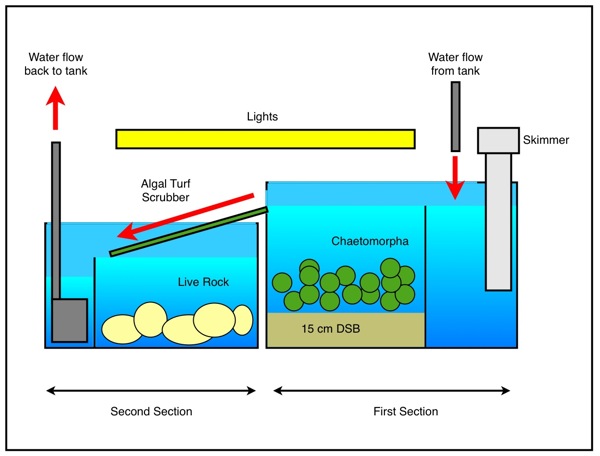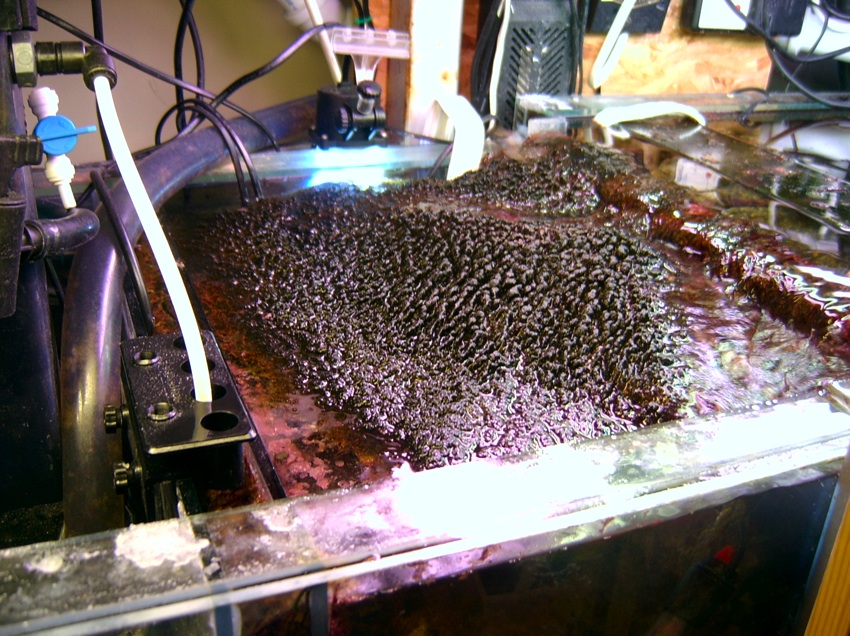|
|
How to make a simple Algae Turf
Scrubber
|
By Simon Trippick |
My rationale for incorporating an algal turf scrubber (ATS), into a
reef aquarium is two-fold. Firstly, I wanted to provide a habitat for
micro-crustaceans, worms and the like to live (see Raabe 2008).
These organisms are useful because they help to process organic waste
and help clear the water of dissolved organic compounds. They also
produce planktonic eggs and larvae that drift into the water stream,
providing live food for filter feeding organisms in the system as a
whole.
Secondly, an algal scrubber would provide a means for nutrient export
through the harvesting of fast-growing turf algae (Raabe 2008).
Design and implementation
Turf algae grows best in the areas of a reef tank where there is a lots
of oxygen and a high level of gaseous exchange. The ATS described here
is nothing more than a simple perspex or glass screen over which water
is allowed to flow. The screen is placed within a portion of the sump
and provides a suitable environment for the turf algae to grow.
When designing my sump I had in mind that I would be incorporating an
ATS from the start, but this can also be achieved within an existing
sump arrangement by diverting some of the overflow over a screen or
plate before entering the sump. Another way to provide a good habitat is
to lower the water level in the last compartment of a sump so that the
water flows down a vertical glass pane.
I had the sump designed as two sections, primarily because it needed to
replace an existing arrangement and this was the only way that I could
get a large sump into my cabinet. As seen in the diagram here, the first
section of the sump has one end lower than the rest. This allows the
water to overflow from this end, across the glass pane of the ATS, and
into the second section of the sump.

Certain features of the sump system, such as the baffles that are
essential to it’s correct operation, have been left off this diagram for
the sake of clarity
The picture below shows the second section, with the overflow part of
the first section shown on the right. As you can see, fixed to the first
baffle in the middle is a thick piece of glass. The ATS pane is designed
to be removable, it rests on the top brace to the right, and this thick
piece of glass to the left. Water is designed to flow over it and into
the compartment underneath.
The next picture shows the another view of the second section, this time
installed underneath my tank. Note that I have not yet put the screen
that makes up the ATS in place yet; at his point the water is simply
flowing from the first section of the sump (mostly out of view) into the
second section of sump visible here.
The ATS screen
In essence, an ATS is nothing more than a flat sheet across which algae
can grow. The next photograph shows the perspex (acrylic) sheet
initially used for this. The transverse bars across were for
strengthening. I have since replaced the perspex sheet with a glass
pane, as I found that even with the strengthening bars in place the
perspex sheet would bow underneath a heavy growth of algae.
The screen is placed on the right hand brace and the supporting bar on
the baffle to the left. Water flows over the sheet from the first stage
of the sump and into the second stage of the sump underneath.
Seeding the algal scrubber
Some turf algae from my reef tank is placed on the screen and
temporarily held in place by some flexible tubing to ‘seed’ the ATS. It
takes a week or so for the turf algae to get a decent hold, after which
the tubing can be safely removed. As you can see in the photograph,
diatoms are starting to build up on the ATS after only a couple of days.
The next photo shows the scrubber two months later, just before I
cropped it for the second time. As you can see, the turf algae has
nearly completely covered the screen! Lighting over the ATS is two 15w
normal-output marine white fluorescent tubes. There are two compact
fluorescent marine white bulbs (36W) lighting the other side of the
section over the Chaetomorpha; some of this light is presumably being
utilised by the turf algae.

It would be interesting to analyse the algae and detritus on the algal
detritus scrubber with a microscope to see what types of life there are
there. Since I do not have such equipment (yet!) I have had to make do
with a magnifying glass. So far I have found copepods, amphipods,
isopods and various worms, mostly of the bristleworm (polychaete)
variety. I am glad that I married my wife before she caught me looking
at algae through a magnifying glass; her face when I was ‘caught in the
act’ spoke volumes!
Results
Alongside fitting an algal turf scrubber, my sump/refugium arrangement has
also been improved through the addition of a remote deep sand bed
(RDSB), the addition of a live rock section, and an expansion of the
water volume. Because of these changes, I can’t say precisely how much
of a difference the incorporation of the ATS has made by itself.
However, taken as a whole, these changes have benefitted my reef tank,
notably with increased growth rates among the scleractinian corals and
generally excellent health among the inhabitants, including the fishes.
Nitrates in the system have been reduced from about 5 ppm average to
just a readable trace since these changes. Phosphates are easier to
control and keep at the lower end of the scale, between 0.001 and 0.003
ppm. Chaetomorpha were already being grown, so the combination of
increased water volume, RDSB, and ATS must be responsible for this. The
aim was never to reduce these parameters to zero, as both are necessary
nutrients. But both nitrate and phosphate do, however, occasionally show
up zero; when this happens then the feeding is increased. In fact I am
now able to feed the system more frequently, and have added an automatic
feeder to provide dried (pelletized) food throughout the day. It would
be interesting to see how a similar system would react if only the ATS
was installed, and none of the other changes mentioned above.
When the turf algae is cropped or purposely disturbed, sending the cloud
of brown detritus collected by the algae (with whatever else is in
there) into the water stream, coral polyp extension is seen to be
exaggerated on certain corals. In particular I have noticed
Hydnophora, Goniopora, Merulina and Galaxia
spp showing this reaction.
The turf algae is cropped once every 2-3 weeks, and I take approx. 75
grams each time (water squeezed out before weighing), leaving about half
the algae on the screen to grow back. To crop the algae I just gently
pull it away from the screen taking care not to pull the whole lot off
at once. It comes away quite easily as the glass is obviously smooth.
This is not a problem, but a potential improvement would be to have a
textured surface on the glass pane to make it easier for the algae to
take hold.
This amount is compared to about 250 grams of Chaetomorpha that I take
at the same time. So, using a basic measurement method, assuming that
both types of algae sequester the same amount of excess nutrients, the
ATS increases the nutrient export of the algal side of my system by
about 30%.
As we all know, space is at a premium in most reef tanks, and inside the
cabinet itself is no exception. In my opinion, an algal turf scrubber
makes a useful addition to a fishless refugium design, taking up very
little space while delivering benefits in terms of water quality
improvement and the production of planktonic food.
Acknowledgements:
I would like to thank Charles Raabe for his inspiration on this project,
and also Neale Monks for his input with the content and help with the
diagram.
Reference
Raabe, C.
A Philippine Fringing Reef & The Reef Aquarium
Chucksaddiction.com (2008)
|
Algal Filtration on WWM
Related FAQs:
Algae Filtration,
Algal Filtration 2,
"Mud" Filtration, Mud
Filtration 2, Mud
Filtration 3,
Reef Set-Up,
Reef Set-Up 2, Reef
Set-Up 3,
Reef Set-Up 4,
Reef Set-Up 5,
Reef Maintenance,
Sumps/Filters,
Sumps/Filters 2,
Marine System Plumbing, Marine
Aquarium Set-Up, Live Rock, Live
Sand,
Fish-Only Marine Set-ups,
Fish-Only
Marine Systems 2,
FOWLR/Fish and Invertebrate Systems,
Reef Systems,
Coldwater Systems,
Small Systems,
Large Systems, Best
Marine Set-Up FAQs 1,
Best FAQs 2,
Marine Set-Up 1,
Related Articles:
Marine
Filtration,
Mechanical,
Physical,
Chemical,
Algae Control,
Nutrient Control and Export, Marine
Set-Up,
An
Introduction to Reef Systems,
Refugiums,
Reef Filtration, Marine
System Plumbing, Marine
Aquarium Set-Up, Moving
Aquariums, Marine
Biotope,
Marine Landscaping,
|
|
| |
|
|
|
